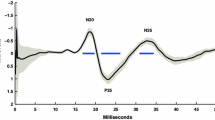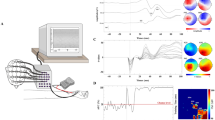Abstract
Little is known about evoked potential changes in putaminal haemorrhage. In this study, somatosensory evoked potentials (SEPs) and motor evoked potentials (MEPs) have been serially evaluated and their role in the prognosis of putaminal haemorrhage is now reported. Nineteen patients with CT- or MRI-proven putaminal haemorrhage were examined after a mean duration of 13 days (range 2–30); there were 4 females and 9 males, ranging in age between 25 and 70 years. The haematomas were of medium size in 13 and large or small in 3 patients each. The changes in the clinical picture and the SEPs and MEPs were evaluated on admission, and after 30 and 90 days. Central motor conduction time (CMCT) could not be recorded in 13, but was prolonged in 2 and normal in 4 patients. Median SEPs revealed the absence of near field potentials in 11 and prolongation of N9–N20 conduction time in 1 patient. In the follow-up period MEP and SEP abnormalities only changed in 5 patients; MEPs changed in 4 and SEPs in 2. The period of normalisation of MEPs ranged between 1 and 6 months. CMCT correlated with motor and N9–N20 conduction time with sensory impairment. Eight patients had poor, 6 partial and 5 complete recovery. Power, sensation, CMCT, and size and location of haematoma made positive contributions to recovery.
Similar content being viewed by others
References
Caplan LR (1992) Intracerebral haemorrhage. Lancet 339:656–658
Cote R, Hachinski VC, Shurvell PSL, Norris JW, Wolfson C (1980) The Canadian neurological scale: a preliminary study in acute stroke. Stroke 17: 731–737
Desmedt JE, Cheron G (1980) Somatosensory evoked potentials to finger stimulation in healthy octogenerians and young adults: wave form, scalp topography and transit times of parietal and frontal components. Electroencephalogr Clin Neurophysiol 50: 404–442
Fieschi C, Carole A, Morelli M, Argentino C, Bozzao L, Fazio C, Salvetti M, Bastianello S (1987) Changing prognosis of intracerebral haemorrhage: results of a clinical and computed tomographic follow-up study of 104 patients. Stroke 19:192–195
Heald A, Bates D, Cartlidge NEF, French JM, Miller S (1993) Longitudinal study of central motor conduction time following stroke. II. Central motor conduction measured within 72 h after stroke as a predictor of functional outcome at 12 months. Brain 116: 1371–1385
Heir DB, Davis KR, Richerdson JR, Mohr JP (1977) Hypertensive putaminal hemorrhage. Ann Neurol 1: 512–519
Inoue Y, Takomoto K, Miyamoto T, Yoshikawa N, Taniguchi S, Sivai S, Nashimura Y, Katsu T (1980) Sequential computed tomography scans in acute cerebral infarction. Radiology 135:665–672
Jenkins WM, Merzenich MM (1987) Reorganisation of neocortical representation after brain injury: a neurophysiological model of the basis of recovery from stroke. In: Seil FJ, Herbert E, Carlson BM (eds) Progress in brain research. Elsevier, Amsterdam, pp 249–266
Kalita J, Misra UK (1994) Putaminal haemorrhage: clinical, radiological and evoked potential study. Neurology (India) 42:13–18
Macdonell RAL, Donnan GA, Bladin PF (1989) A comparison of somatosensory evoked and motor evoked potentials in stroke. Ann Neurol 25:68–73
Mahony FI, Barthel DW (1986) Functional evaluation: the Barthel index. Md Med J 14:61–65
Misra UK, Kalita J (1995) Putaminal haemorrhage leading to pure motor hemiplegia. Acta Neurol Scand 91: 283–286
Misra UK, Kalita J (1995) Ipsilateral motor response — is it an artifact? Electroencephalogr Clin Neurophysiol (in press)
Misra UK, Kalita J (1995) Prognostic significance of central motor conduction on the non-hemiplegic side in supratentorial hematoma. Electroencephalogra Clin Neurophysiol (in press)
Misra UK, Sharma VP (1994) Central and peripheral conduction studies in lathyrism. J Neurol Neurosurg Psychiat 57:572–577
Mizukami M, Nishijima M, Kin H (1981) Computed tomographic findings of good prognosis for hemiplegia in putaminal hemorrhage. Stroke 12: 648–652
Moriguchi I, Kotsu K, Matsushita Y (1980) Adaptive least squares method applied to structure activity correlation of hypotensive N-alkylN”cyanoN′ pyridylguanidines. J Med Chem 23:20
Omae T, Ueda K, Ogata J, Yamaghdei T (1989) Parenchymatous haemorrhage: etiology, pathology and clinical aspect. In: Toole JE (ed) Handbook of clinical neurology, vol 10 (54). Elsevier, Amsterdam, pp 287–331
Thompson PD, Day BL, Rothwell JC, Marsden CD (1987) The interpretation of electromyographic response to elictrical stimulation of the motor cortex in diseases of upper motor neuron. Neurol Sci 80:91–110
Weisberg LA, Stazio A, Elliott D, Shamsina M (1990) Putaminal hemorrhage: clinical-computed tomographic correlations. Neuroradiology 32: 200–206
Author information
Authors and Affiliations
Rights and permissions
About this article
Cite this article
Misra, U.K., Kalita, J. Serial changes in motor and somatosensory evoked potentials in putaminal haemorrhage. J Neurol 243, 73–78 (1996). https://doi.org/10.1007/BF00878535
Received:
Revised:
Accepted:
Issue Date:
DOI: https://doi.org/10.1007/BF00878535




